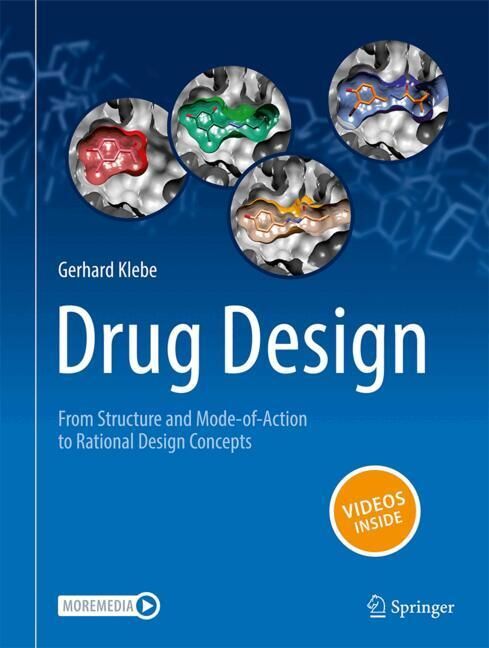Drug Design
Drug Design
This English-language textbook, based on the successful German edition 'Wirkstoffdesign', brings the subject of drug design back to the cutting edge of research. The reader learns about new methods in genetic engineering and the expanded range of structural biological methods. Especially in the last 10 years, many complex target structures such as G-protein coupled receptors or ion channels have been elucidated by using these methods. The reader learns how these long-sought complex structures with classical drugs look like and how the therapeutic effect is achieved.
This textbook is aimed at students of pharmacy, chemistry and the life sciences, but also at career changers and medicinal chemists in research and development departments of the pharmaceutical industry. Conceptually, it is very different from classical textbooks on pharmaceutical chemistry. It focuses on the path to a new drug substance. The selection of case studies is based on didactic aspects and attempts to give a broad overview of methods and strategies without forgetting to look back at the beginnings of this field of work. Thus, the arc spans from the history of drug research, the mechanisms of action of drugs and the methods for lead structure search and optimisation to structure determination methods, modelling, molecular dynamics and QSAR methods to structure- and computer-aided design.
This textbook also discusses new methods and concepts such as epigenetics, the PROTAC approach, CRISPR-Cas9 gene scissors, structural predictions from sequence, the use of artificial intelligence and new screening technologies from biophysics. It presents successes in disrupting or enhancing protein-protein interactions as a concept for drug therapy and discusses optimising drugs considering their thermodynamic as well as kinetic binding profiles .
Videos via app: simply download the SN More Media app free of charge, scan a link with the play button and immediately play the video on your smartphone or tablet.
Preface
Introduction.- Part I Fundamentals of drug research1 Drug research yesterday, today, tomorrow
2 In the beginning there was serendipity
3 Examples of classical drug research
4 Protein-ligand interactions as the basis of drug action
5 Optical activity and biological action.- Part II The search for lead structure
6 The classical search for lead structure
7 Screening technologies for lead structure search
8 The optimisation of lead structure
9 The design of prodrugs
10 Peptidomimetics. 6 The classical search for lead structure
7 Screening technologies for lead structure search
8 Lead structure optimisation
9 Design of prodrugs
10 Peptidomimetics.Part III Experimental and theoretical methods
11 Combinatorics: chemistry with large numbers
12 Genetic engineering in drug discovery
13 Experimental methods for structure elucidation
14 Description of the structure of biomolecules
15 Molecular modelling
16 Conformational analysis.- Part IV Quantitative structure-activity relationships and design methods
17 Pharmacophore hypotheses, molecular comparisons and database searches
18 Quantitative structure-activity relationships
19 From in vitro to in vivo: optimising ADME tox properties
20 Protein modelling and structure-based drug design
21 An example: structure-based design of inhibitors of tRNA-guanine transglycosylase.- Part V Successes in rational drug design
22 How drugs work: targets for therapy
23 Inhibitors for hydrolases with acyl enzyme intermediates
24 Inhibitors of aspartyl proteases
25 Inhibitors of hydrolytically cleaving metalloenzymes
26 Inhibitors for transferases
27 Inhibitors for oxidoreductases
28 Agonists and antagonists for nuclear receptors
29 Agonists and antagonists of membrane receptors
30 Ligands for channels, pores and transporters
31 Ligands for surface receptors
32 Biopharmaceuticals: peptides, proteins, nucleotides and macrolides as active substances.
Klebe, Gerhard
| ISBN | 978-3-662-68997-4 |
|---|---|
| Artikelnummer | 9783662689974 |
| Medientyp | Buch |
| Copyrightjahr | 2025 |
| Verlag | Springer, Berlin |
| Umfang | XXVIII, 684 Seiten |
| Abbildungen | XXVIII, 684 p. 405 illus., 55 illus. in color. With online files/update. |
| Sprache | Englisch |










